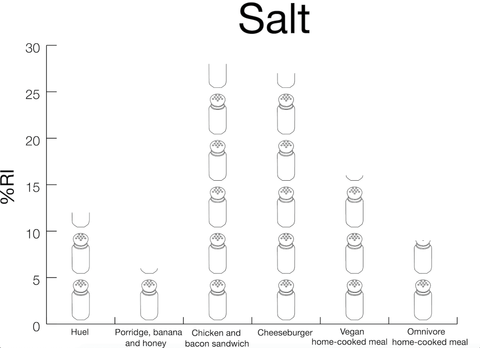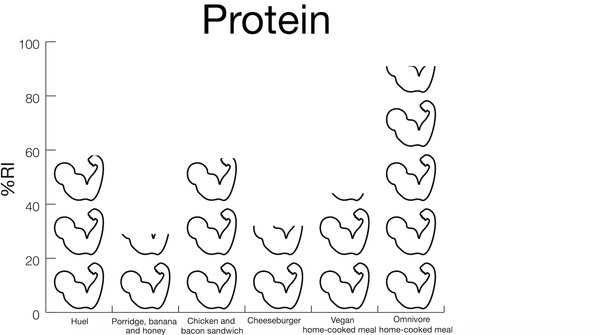Why Huel Exists
We’ve nailed down the 4 main reasons as to why you might have Huel in your life: nutrition, convenience, sustainability and price. The priority you place on these reasons will vary depending on your values, the time of day, where you are and how you’re feeling.
Huel Powder (v3.0) Vanilla was compared to:
- Porridge cooked from rolled oats, with semi-skimmed cow’s milk, banana and honey
- Prepackaged chicken and bacon sandwich
- Fast-food cheeseburger
- Home-cooked grilled chicken, baked sweet potato wedges and steamed broccoli (Omnivore home-cooked meal)
- Home-cooked mixed bean chilli with brown rice (Vegan home-cooked meal)
So, have a look at Huel vs. each of the meals. What do you think?
You can check out which ingredients made up these meals and more information on how each graphic was made here.



A stand-out figure for a Huel Powder meal is it has the lowest amount of sugar, even against the savoury meals and it’s high in protein too. Sweet potato is the driver of the sugar content for the omnivore home-cooked meal; it’s important to remember that the fibre in sweet potato slows the absorption of sugar into the body, unlike free sugars from confectionary.
The reference intake for salt is 6g but it’s widely agreed we should be consuming less. Both the sandwich and cheeseburger contain at least 1.6g of salt which is around double the amount in the other foods. Preprepared convenience foods often have high “hidden” salt contents.



We looked at the main vitamins and minerals that tend to be lacking in a typical Western diet. We’ve picked out 3 and you can check out a few more in the raw data section. Both of the home-cooked diets provide large amounts of vitamin C because of the vegetables included, something which the sandwich and burger lack. Vitamin D (pictured above) can be hard to get in most diets and vitamin B12 is all but absent from plant-based foods. As a result, both are provided in ample amounts from Huel.
Magnesium and potassium (pictured above) can be found in high amounts in whole grains (such as oats), vegetables, seeds (for example flaxseed) and nuts so they are relatively easy to consume from a majority wholefood diet.
Convenience

The graphics can’t take into account if the meal can be eaten on the go or the time taken to travel and purchase the food/s. If you don’t have the time to make a nice home-cooked meal, what do you choose, a shop-bought sandwich, a takeaway cheeseburger or Huel Powder?
Sustainability

Meat from cows, sheep and goats has by far the largest carbon footprint because ruminant animals produce significantly more methane than others, which is why the cheeseburger stands out. Poultry, fish and dairy are the second highest contributors, and plant-based sources have the lowest carbon footprint.
The carbon footprint is based on an average, and there are large variations for the same food for several reasons. 6% of a food’s total carbon footprint comes from food miles and this figure only fluctuates a little even if a food is flown halfway around the world [1]. We waste a third of all the food we produce and in the developed world the majority of this occurs at the consumer level [2]. Food waste is not taken into account in the graph above.
Price

Prices are based on an average of the largest 4 supermarkets in the UK. Where multiple ingredients are required meals were based on cooking for two people where possible. Home-cooked meals can vary a lot in price and so the above provides just two examples. It’s a good illustration of the trade-off between price, nutrition, convenience, and quality.
The final score

So what happens when you rank these meals for each consideration above and put them into a graph? Well, see for yourself. The meal that scores the best in a category gets 6 points and the meal that scores the worst gets 1. The porridge scores highly because of its low carbon footprint and cost even though it’s relatively low in vitamins and minerals. The omnivore and vegan home-cooked meals are the best in terms of nutrition but the vegan meal edges ahead because of sustainability and price.
Huel Powder comes out on top because it has one of the lower carbon footprints, takes little time to make and has a great nutritional profile. When you’re short on time or on the go and a lovely home-cooked meal is just out of reach, think Huel.
References
- Ritchie H. Our World in Data. You want to reduce the carbon footprint of your food? Focus on what you eat, not whether your food is local. Date Accessed: 11/02/21. [Available from: https://ourworldindata.org/food-choice-vs-eating-local]
- Searchinger T, et al. Creating a Sustainable Food Future. 2019. Available from: https://wrr-food.wri.org/sites/default/files/2019-07/WRR_Food_Full_Report_0.pdf]





